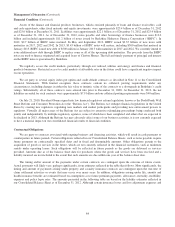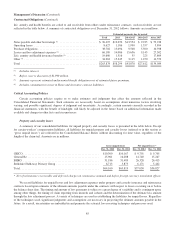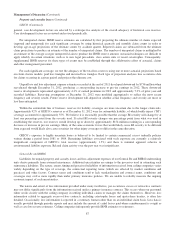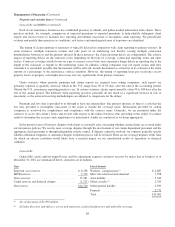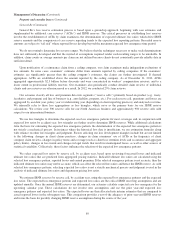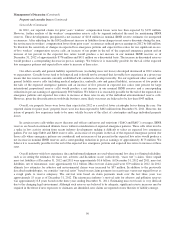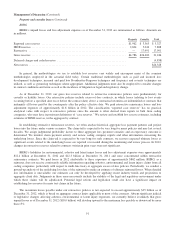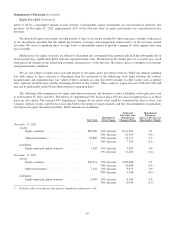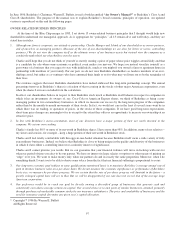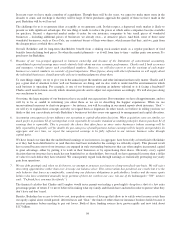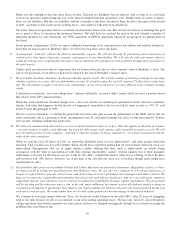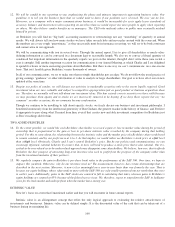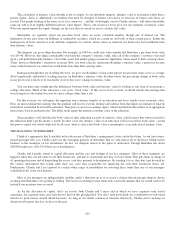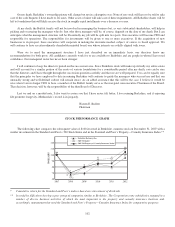Berkshire Hathaway 2012 Annual Report Download - page 95
Download and view the complete annual report
Please find page 95 of the 2012 Berkshire Hathaway annual report below. You can navigate through the pages in the report by either clicking on the pages listed below, or by using the keyword search tool below to find specific information within the annual report.
Management’s Discussion (Continued)
Derivative contract liabilities (Continued)
actual exchange are affected by market conditions and perceptions of the buyers and sellers. Actual values in an exchange may
differ significantly from the values produced by any mathematical model. Dollars are in millions.
Hypothetical change in volatility (percentage points) Hypothetical fair value
Increase 2 percentage points .............................................................. $7,955
Increase 4 percentage points .............................................................. 8,414
Decrease 2 percentage points .............................................................. 7,057
Decrease 4 percentage points .............................................................. 6,625
In addition, we have exposures relating to a number of credit default contracts written involving corporate and state/
municipality issuers. As of December 31, 2012, all credit default contracts involving corporate issuers will expire in 2013.
Values associated with these contracts are no longer significant, as the risks of loss are no longer significant. Our states/
municipalities exposures begin to expire in 2019. The fair values of our state/municipality issuer credit default contracts are
generally based on bond pricing data on the underlying bond issues and credit spread estimates. We monitor and review pricing
data and spread estimates for consistency as well as reasonableness with respect to current market conditions. We make no
significant adjustments to the pricing data or inputs obtained.
Prices in a current market trade involving identical (or sufficiently similar) risks and contract terms as our equity index put
option or credit default contracts could differ significantly from the fair values used in the financial statements. We do not
operate as a derivatives dealer and currently do not utilize offsetting strategies to hedge these contracts. We intend to allow
these contracts to run off to their respective expiration dates.
Other Critical Accounting Policies
We record deferred charges with respect to liabilities assumed under retroactive reinsurance contracts. At the inception of
these contracts, the deferred charges represent the excess, if any, of the estimated ultimate liability for unpaid losses over the
consideration received. Deferred charges are amortized using the interest method over an estimate of the ultimate claim
payment period with the periodic amortization reflected in earnings as a component of losses and loss adjustment expenses.
Deferred charge balances are adjusted periodically to reflect new projections of the amount and timing of remaining loss
payments. Adjustments to deferred charge balances resulting from changes to these assumptions are determined retrospectively
from the inception of the contract. Unamortized deferred charges were approximately $4.0 billion at December 31, 2012.
Significant changes in the estimated amount and payment timing of unpaid losses may have a significant effect on unamortized
deferred charges and the amount of periodic amortization.
Our Consolidated Balance Sheet as of December 31, 2012 includes goodwill of acquired businesses of $54.5 billion, which
includes $1.4 billion arising from our various acquisitions in 2012. We evaluate goodwill for impairment at least annually and
conducted our most recent annual review during the fourth quarter of 2012. Such tests include determining the estimated fair
values of our reporting units. There are several methods of estimating a reporting unit’s fair value, including market quotations,
underlying asset and liability fair value determinations and other valuation techniques, such as discounted projected future net
earnings or net cash flows and multiples of earnings. We primarily use discounted projected future earnings or cash flow
methods. The key assumptions and inputs used in such methods may include forecasting revenues and expenses, operating cash
flows and capital expenditures, as well as an appropriate discount rate and other inputs. A significant amount of judgment is
required in estimating the fair value of a reporting unit and performing goodwill impairment tests. Due to the inherent
uncertainty in forecasting cash flows and earnings, actual future results may vary significantly from the forecasts. If the carrying
amount of a reporting unit, including goodwill, exceeds the estimated fair value, then individual assets (including identifiable
intangible assets) and liabilities of the reporting unit are estimated at fair value. The excess of the estimated fair value of the
reporting unit over the estimated fair value of net assets would establish the implied value of goodwill. The excess of the
recorded amount of goodwill over the implied value is then charged to earnings as an impairment loss.
Market Risk Disclosures
Our Consolidated Balance Sheets include a substantial amount of assets and liabilities whose fair values are subject to
market risks. Our significant market risks are primarily associated with interest rates, equity prices, foreign currency exchange
rates and commodity prices. The fair values of our investment portfolios and equity index put option contracts remain subject to
considerable volatility. The following sections address the significant market risks associated with our business activities.
93



